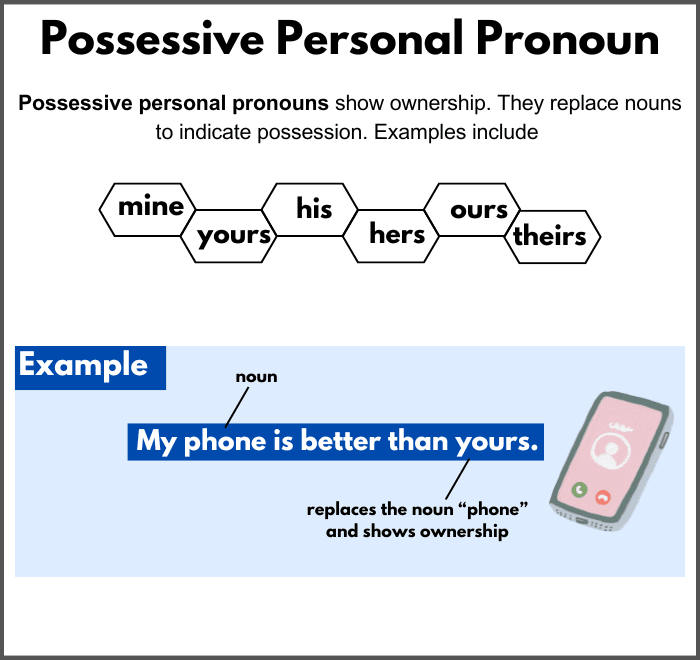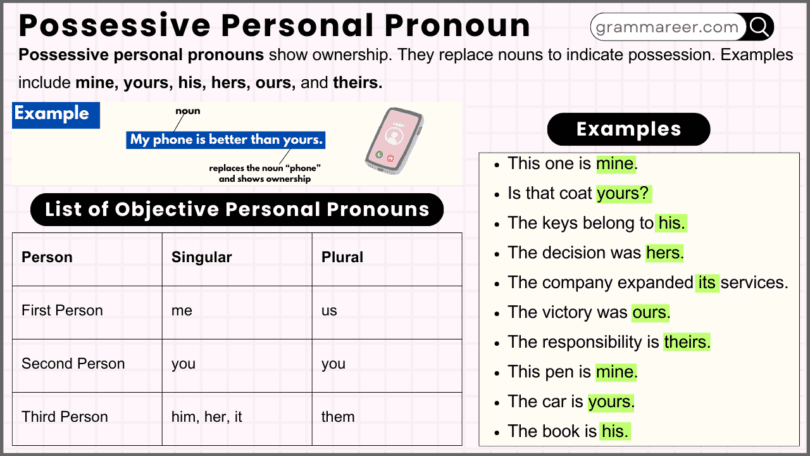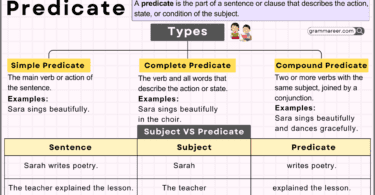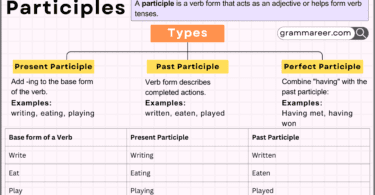English grammar uses various types of pronouns to simplify communication. Among them, a possessive personal pronoun is crucial for showing ownership and reducing redundancy in sentences. These pronouns not only enhance clarity but also improve sentence flow, making your writing or speech more effective.
Possessive personal pronouns show ownership. They replace nouns to indicate possession. Examples include mine, yours, his, hers, ours, and theirs.
Table of Contents
Examples of Possessive Personal Pronouns
Here are some examples of these pronouns:
- This one is mine.
Mine shows that the speaker owns the item.
- Is that coat yours?
Yours shows that the person being spoken to owns the coat.
- The keys belong to his.
His shows that the keys belong to a male person.
- The decision was hers.
Hers shows that the decision belongs to a female person.
- The company expanded its services.
Its shows that the company owns the services.
- The victory was ours.
Ours shows that the victory belongs to the speaker and others.
- The responsibility is theirs.
Theirs shows that the responsibility belongs to other people.
Possessive Personal Pronoun vs. Possessive Determiner
| Aspect | Possessive Personal Pronoun | Possessive Determiner |
|---|---|---|
| Definition | A pronoun that shows ownership and stands alone in place of a noun. | A word that shows ownership and is used before a noun. |
| Examples | Mine, yours, his, hers, ours, theirs | My, your, his, her, our, their |
| Usage in a Sentence | Replaces the noun entirely. Example: The book is mine. | Modifies the noun. Example: This is my book. |
| Position in Sentence | Stands alone, usually after the verb or preposition. Example: Is this pen yours? | Comes before the noun it modifies. Example: Her coat is blue. |
| Function | Acts as a noun substitute in the sentence. | Acts as an adjective, modifying a noun. |
| Key Difference | Does not need a noun after it. | Always requires a noun after it. |
Why Possessive Personal Pronouns Are Important
Possessive personal pronouns simplify sentences, making them more concise and readable. They enhance communication by removing unnecessary repetition and ensuring clarity in ownership.
For example:
- Repetitive: This is the laptop that belongs to Ahmed.
- Concise: This laptop is his.
By incorporating these pronouns, you can make sentences flow better, both in writing and speaking.
Common Mistakes and How to Avoid Them
- Confusing possessive pronouns with determiners
✖ This bag is my.
✔ This bag is mine. - Using apostrophes incorrectly
✖ The cat wagged its’ tail.
✔ The cat wagged its tail.
Its (without an apostrophe) is a possessive determiner, while it’s means it is. - Incorrect plural forms
✖ This idea is our’s.
✔ This idea is ours.
To avoid these errors, practice recognizing the role of pronouns and their forms.
FAQs
A possessive personal pronoun shows ownership and replaces a noun entirely. Examples include mine, yours, his, hers, ours, and theirs.
Possessive adjectives (or determiners) modify a noun (my house), while possessive personal pronouns replace it entirely (mine).
No, its is a possessive determiner. Possessive pronouns replace nouns, while determiners modify them.
This book is mine.
The victory was theirs.
The cat is hers.
The victory was ours.
The responsibility is theirs.
They make sentences concise and improve clarity, ensuring smoother communication in both formal and informal contexts.
Conclusion
Mastering possessive personal pronouns is essential for fluent and effective English. They simplify sentences by reducing repetition and expressing ownership clearly. Practice using them to enhance both your written and spoken communication.
You May Also Like





